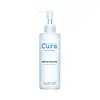What's inside
What's inside
 Key Ingredients
Key Ingredients

No key ingredients
 Benefits
Benefits

 Concerns
Concerns

 Ingredients Side-by-side
Ingredients Side-by-side

Water
Skin ConditioningQuaternium-60
Propylene Glycol
HumectantCarbomer
Emulsion Stabilising1,2-Hexanediol
Skin ConditioningCarica Papaya Fruit Extract
Skin ConditioningCitric Acid
BufferingScutellaria Baicalensis Root Extract
AstringentGlycyrrhiza Glabra Root Extract
BleachingSodium Hyaluronate
HumectantHydroxyethyl Urea
HumectantCeramide NP
Skin ConditioningCentella Asiatica Extract
CleansingMelaleuca Alternifolia Leaf Extract
PerfumingAllantoin
Skin ConditioningBetaine Salicylate
AntimicrobialOctyldodecanol
EmollientPolygonum Cuspidatum Root Extract
AntioxidantCamellia Sinensis Leaf Extract
AntimicrobialRosmarinus Officinalis Leaf Extract
AntimicrobialChamomilla Recutita Flower Extract
MaskingPentylene Glycol
Skin ConditioningButylene Glycol
HumectantCaprylyl Glycol
EmollientDisodium EDTA
Water, Quaternium-60, Propylene Glycol, Carbomer, 1,2-Hexanediol, Carica Papaya Fruit Extract, Citric Acid, Scutellaria Baicalensis Root Extract, Glycyrrhiza Glabra Root Extract, Sodium Hyaluronate, Hydroxyethyl Urea, Ceramide NP, Centella Asiatica Extract, Melaleuca Alternifolia Leaf Extract, Allantoin, Betaine Salicylate, Octyldodecanol, Polygonum Cuspidatum Root Extract, Camellia Sinensis Leaf Extract, Rosmarinus Officinalis Leaf Extract, Chamomilla Recutita Flower Extract, Pentylene Glycol, Butylene Glycol, Caprylyl Glycol, Disodium EDTA
 Reviews
Reviews

Ingredients Explained
These ingredients are found in both products.
Ingredients higher up in an ingredient list are typically present in a larger amount.
Butylene Glycol (or BG) is used within cosmetic products for a few different reasons:
Overall, Butylene Glycol is a safe and well-rounded ingredient that works well with other ingredients.
Though this ingredient works well with most skin types, some people with sensitive skin may experience a reaction such as allergic rashes, closed comedones, or itchiness.
Learn more about Butylene GlycolRosmarinus Officinalis Leaf Extract comes from rosemary. Rosemary is native to the Mediterranean.
While Rosmarinus Officinalis Leaf Oil can be volatile due to its fragrant properties, the fragrance components are usually removed in the leaf extract.
Rosemary Leaf Extract contains many antioxidants such as rosmarinic acid and caffeic acid. Rosemarinic acid, a compound found in rosemary leaf, has been found to help soothe skin conditions such as eczema and acne.
Learn more about Rosmarinus Officinalis Leaf ExtractWater. It's the most common cosmetic ingredient of all. You'll usually see it at the top of ingredient lists, meaning that it makes up the largest part of the product.
So why is it so popular? Water most often acts as a solvent - this means that it helps dissolve other ingredients into the formulation.
You'll also recognize water as that liquid we all need to stay alive. If you see this, drink a glass of water. Stay hydrated!
Learn more about Water